QuestionQUESTION: Hi,
I have a 9 month old,foot long bearded dragon named Fred. He was always a great eater, active, & "regular" from the time I got him, until I got a chinese water dragon. Fred could see the other one across the counter top & I had to put a towel on Freds cage, since he was literally trying to bust out of the glass to get at the other lizard. At that time Fred stopped eating so well, & only went to the bathroom about twice a week. Fortunately for all involved, I had a friend who loved water dragons, & took mine to raise as his own. Happy ending. At the same time, we moved to a new house & now Fred is not on top of a fridge, but at people level & cat level. Fred has not gone to the bathroom in two weeks, & is not eating well either. When you pick him up, he is very active & alert. I am concerned though. Is this just a normal adjustment period for him in a new environment? I gave him a nice warm bath tonite, a rubdown, & lots of love. Can you please give me some advice? You were right on the money the last time I asked you a question. I am confident that you know what you are talking about. I just don't want to lose Fred.
Thank you so much for your help.
lauren
ANSWER: Hi Lauren,
They do stress with any change, as you have seen. He has lots of changes...new home, cat, people, etc.
I would double check your temperatures to make sure he has the needed temperature ranges...refer to the care sheet I sent you previous. If you can't find it, let me know and I will send you a new one.
Stress can also cause an overload of internal parasites, which can cause an impaction or blockage. Can also be caused by dehydration. Have you offered water by a spray bottle or eye dropper? If not, do try that.
Have you tried soaking him in a warm tub with very, very gentle belly massages? Many times that will help them go. Many people also mix a few drops of olive oil with some babyfood fruit and offer with a syringe. Baby food prunes also help a lot. Its what I use for my iguanas. The only problem with using something to help them go is that if it is a foreign body blockage, then the "force" of them trying to go can cause tears to their intestines, stomach and or bowel. If you are positive its not a blockage due to a foreign object(sand,bark,litter,money,etc, etc) then offering some of the babyfood prunes may help soften the stool..the warm bath is also important.
Prolonged constipation in reptiles can cause a prolapse. If he would happen to prolapse, soak his bottom in a heavy sugar/water mix..many times the mix helps to shrink the tissue, allowing it to go back in place. Also, if a prolapse, a vet is needed asap ...you can take gauze and soak it in the sugar/water solution, and place it on your beardies vent area on the way to the vet...keep the gauze well soaked. It will help prevent drying out of the exposed tissue.
I tell you about what to do in case of a prolapse so that if it does happen, you don't have to waste time trying to find out what to do.
Also, when reptiles go for periods of not eating much, or even just stress, their needed gut bacteria drops. When the bacteria is low, they don't digest their foods properly so they may not be hungry as normal..and of course, not eating means nothing coming out the other end. When this happens, we have to step in and use something to boost their gut bacteria levels back up to where they are needed. To do this we can use a few different products.
bene bac...labeled for birds, approved for reptiles.
nutri bac
acidolophliz+
or plain, human grade acidolophus...... one capsule will dose for at least 3 days in a row.
BeneBac ..most larger pet stores should carry it...especially if they have birds...
Acidophiliz+ I think PetsMart carries it..if not....on line at www.reptilesupply.com
Some people use a tiny amount(1/2 cc or less) of live culture plain yogurt for 2-3 days, but this is only something that is recommended for healthy reptiles.
---------- FOLLOW-UP ----------
QUESTION: Hi Diane,
I will try to reduce the stress. I did give him a warm bath last night & he didnt seem to mind for about 5 minutes. I always give him gentle belly massages. I unfortunately do not have the necessary temperatures at hand due to the move, & would really appreciate you sending them to me for him. I usually keep his tank around 90-100 at one end, & about 80 at the other. He has a rock he climbs on to get closer to the light if needed. I am in the process of getting a larger tank for him-I hope that doesnt stress him anymore.
He is a strong,well built guy, so I am hoping that he will bounce back. I am picking up some applesauce tonight for him, & will try the syringe for extra goodies. Wish me luck & thank you so much!!!
Lauren
AnswerHi Lauren,
I will include the care sheet for you. Temperatures are listed in it.
As to the applesauce, I would go with the prunes if he hasn't gone potty yet.
Applesauce/apples can sometimes act as an appetite suppressant. If you want to use fruit other than prunes, pears or one of the others would be a good choice. He may even prefer the veggies!!!
Good he is a strong boy!!! Best of luck getting your monster back on track!!
BASIC BEARDED DRAGON CARE:
HOUSING:
For an adult bearded Dragon, a 50 -55 gallon is the smallest recommended tank. For a baby, nothing less than a 30 gallon tank will work for a very short time, so its best to just start out with the adult sized tank....you can add rocks and branches for climbing, being sure to not stack rocks too high to prevent them toppling over. Branches need to be secure. They like to have a hide log or cave too!! All items brought from outside need to be cleaned well before placing them in the BD's tank. To clean them, there are a few methods: to wash in a bleach solution of 1/4 cup of bleach to 1 gallon of water. Let them soak for about an hour, rinse them in hot water several times and then let them dry in the sun until completely dry. If the items are small enough, they can be baked in an over at 200 degrees for about 2 hours, check often to be sure they are not starting to burn. The items can also be boiled(simmered) for 30 minutes or so and then allowed to dry completely before
placing in the tank. I also suggest washing any pet store items such as caves, rocks, branches, etc before placing in the tank as that if the store would happen to have mites they can also be on the items we purchase. Any of the above methods are acceptable for cleaning. CAUTION!!! On store bought branches...be VERY careful with the driftwood pieces that have the holes in them!!! Be sure the holes are small as that if the holes are large, the BD MAY be able to get his head in them but not able to get it back out!!! A secure screen top is necessary for bearded dragons as that also they do not require much height for climbing..they can and do climb!! NEVER USE HEAT ROCKS OR HEATED CAVES!!! They malfunction and cause severe burns and even death!!!!
SUBSTRATES:
Young bearded dragons MUST be kept on paper towels, newspaper or other non particulate(loose) substrate to prevent them from getting any loose substrate into their mouth and swallowing it which can and does cause intestinal blockages.Once the BD is over 10 inches, some people have had good luck using play sand mixed with 50% of peat moss. I prefer the safe substrate of the newspaper, or other non particulate substrate to prevent any problems and also for ease of cleaning.
LIGHTING:
BD's need UVB, which is the special lights that come in fluorescent tubes or special screw in bulbs(mercury vapor)that are designed to produce uvb and heat. The tubes do not produce heat. UVB is needed by the BD
to be able to absorb the calcium in the foods they eat. Without the uvb, they will develop metabolic bone disease.
With the tubes, they must say that they produce BOTH uvb and uva. The uvb needs to be 5% or higher. Repti Sun 5.0 and 10.0(not compact) are TWO of the best uvb tubes on the market. The repti glo 8.0's are a great uvb source also. Arcadia 5.0 (UK), which is the uvb tube available in the UK is a good uvb tube. These need to be positioned 6-8 inches(for the 5.0 and 8.0 and 8-10 inches for the 10.0) over the BD so that they get the uvb that is needed. Recommended length of the tube is 24 inches or more. They need to be replaced every 6-9 months as that they stop producing uvb long before they stop producing light. They need to have access to uvb and basking temperatures for 10-12 hours daily. At night, no white lights!!! There has been new studies that have proven that compact uvb lights, both the spiral/coil type and the ones that look like long "U's" laying on their side and a few other brands are causing what basically amounts to snow blindness in reptiles. To read more on this, you can go to
http://www.uvguide.co.uk/index.htm Here is a link to a letter from RZilla on their product: http://www.zilla-rules.com/assets/006/13278.pdf
There are tubes and bulbs that say ''full spectrum'' but they do not produce any uvb.
On the mercury vapor , they also produce heat. They also produce the uvb and uva. The best on the market now are the
MEGA RAY or the T-Rex. www.reptileuv.com has more information on the Mega Ray lights. When using these, the distance is much greater than the uvb tubes and the directions must be followed that are listed for the light. When using the mercury vapor lights, you don't need to have one light for uvb and one for heat. The Mercury vapor lights provide both.
HEATING AND TEMPERATURES:
Bearded Dragons have specific temperature requirements. For heat when using the uvb producing fluorescent tubes, a regular household lightbulb will work for DAYTIME heat. The wattage needed will vary to each situation such as tank size, room temperatures, air flow. Their basking area temperature must be between 95F and 105F degrees to allow proper digestion of food. Your basking area must be where the uvb light is as well as the heat source. Be sure that the BD cannot get too close to the heat source as that they WILL get burned! The ambient temperature range in the mid 80's . Cool daytime range of normal room temperature of low to mid 70's. Nighttime temperatures in the low to mid 60's is fine. NEVER USE HEAT ROCKS!!!!!!!!!!!!!!!!!!!!! A good digital thermometer is a must. I like using the duel ones with the probe...cost about 15$ at Wal Mart. The probe can be placed in the basking area at the BD's level to monitor this temperature and the main unit can be pla
ced in one of the ambient temperature areas. When reading them, the "out" reading is the probe area.
DIET:
Bearded Dragons eat and need both animal proteins and vegetable matter!!! As young dragons they eat a bit more of the insects. As they get older, as adults their diet is more of the vegetable matter. As young BDs, the diet is about 80% animal proteins and 20% vegetable matter. As they get older, the ratio changes. An adult will eat about 80%-90% vegetable matter and 10-20% animal proteins.
Animal protein sources are: Crickets, superworms, silkworms, roaches, hornworms, waxworms. Waxworms are considered candy to a BD so only feed on occasion in a small amount(2-3 worms). ALL insects must be properly gutloaded for at least 48 hours prior to feeding to the dragon. For crickets and superworms, this can be done with vegetables, plain cereals and commercial foods for the species. Silkworms and the other insects have their own diet needs. Its best to feed the crickets in a separate feeding tank such as a 10 or 20 gallon size tank or container with a well vented lid. This can make it easier for the dragon to catch the crickets and prevents any stray crickets in their "home" tank from deciding to nibble on the BD if he happens to not find them all. If you do feed in his home tank, be sure to place a 1/2 potato in the tank to help prevent the crickets from biting at the BD. ALL insects fed must be no larger than the space between their eyes to prevent choking. Be
sure to dust the insects daily(for dragons up to 14-15 inches) (2x wkly there after)with a good calcium source such as Rep Cal calcium powder with no added Phosphorus. Young BD's up to 4 months of age will eat more crickets than anything. At this age they will usually consume anywhere from 10 to 30+ correctly sized crickets three times a day. Be sure to remove any uneaten crickets that are not consumed in a 15-25 minute time frame. For this reason, its easier to use a separate feeding tank for the bearded dragon. A 10 gallon tank(with a screen top) works well. Its best to offer their "salad" of greens/veggies before offering their morning insect feeding when they are hungry to prevent any problems with them preferring NOT to eat their salad. Their salad consists of Collard greens, mustard greens, turnip greens, dandelion greens...... this is the BASE of the green part of their vegetable diet. To this, for variety you can add arugula, escarole, endive,small amounts of
bok choy or other Asian greens. For the vegetable part of the diet, green beans, butternut squash, acorn squash(other winter squashes are also acceptable) yams, sweet potato. For color, sweet peppers can also be added in a small amount. For baby BD's, using a food processor for the greens and veggies works well. As they get older, greens should never be larger than about an inch x an inch in size. Never feed lettuces as they have no nutritional value. The hard veggies should be either food processed or grated. Fruits can also be offered in small amounts. Good fruits are figs, papaya, melon, blueberries, strawberries, raspberries....and many other fruits... these need to be mashed or chopped. Watermelon is a good source of water for the dragon. Their salad can be dusted once or at the most, twice a month with a good vitamin supplement such as RepCal HerptiVit. This is by no means a complete list of foods the dragons can eat.
You can also offer baby food chicken or small bits of boiled chicken.
Be sure to provide a dish of FRESH drinking water at ALL times!!! Misting their salad will also help get much needed water into them. NEVER FEED any MICE or other mammals to your Dragon!!!
WATER:
As stated above, always provide a dish of drinking water and mist their salad. You can also bathe your dragon a few times a week. (many bathe them daily for "bathroom duties") Temperature of the water should be between 85 and 95 degrees. The depth should never be any deeper than to cover his back when laying FLAT!!! Never leave them unattended at bath time to prevent possible drowning. Many love to soak and swim for 15 minutes or more. Never bathe less than two hours before his basking lights go out. Doing so can cause him to become too chilled, risking the chance of a respiratory infection.
A vet check up is recommended and a fecal sample taken in to be tested for any internal parasites.... To find a qualified vet in your area you can go to
http://www.herpvetconnection.com
http://www.arav.org/ECOMARAV/timssnet/amm/tnt_mdsearch.cfm
http://www.anapsid.org/vets/
More in-depth care info can be found at:
http://www.bio..miami.edu/ktosney/file/BDcare.html
http://www.sundialreptile.com/care%20sheet--bearded%20dragon.htm
http://www.blackninjakitty.com/herps/dragons
Most bearded dragons will take long naps (generally,if they are over a yr) in the fall.. this is called Brumation. is a form of hibernation. You can read more about that at http://www.bio.miami.edu/ktosney/file/BDbrumate.html

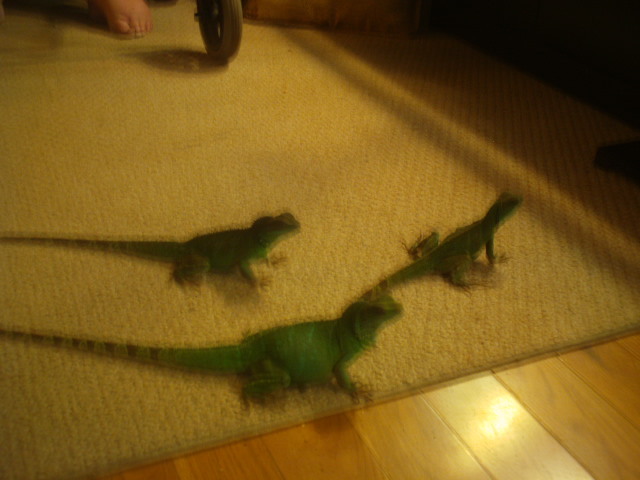 asking for help
Question
female water dragon
i have a female water drag
asking for help
Question
female water dragon
i have a female water drag
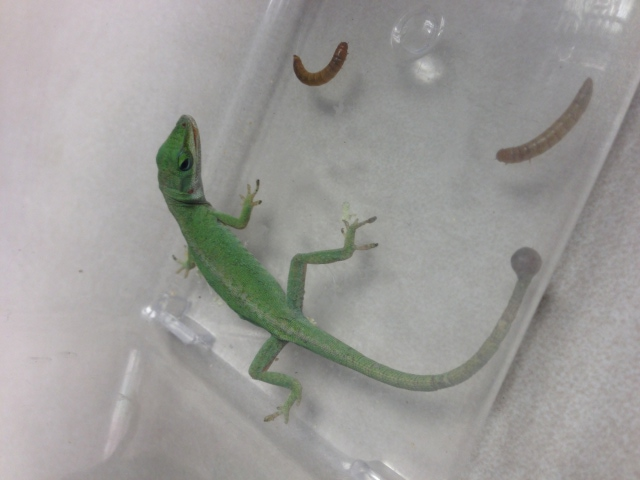 Green Anole, femail, cyst/blister
Question
Axebella
Hello Donna. My son and
Green Anole, femail, cyst/blister
Question
Axebella
Hello Donna. My son and
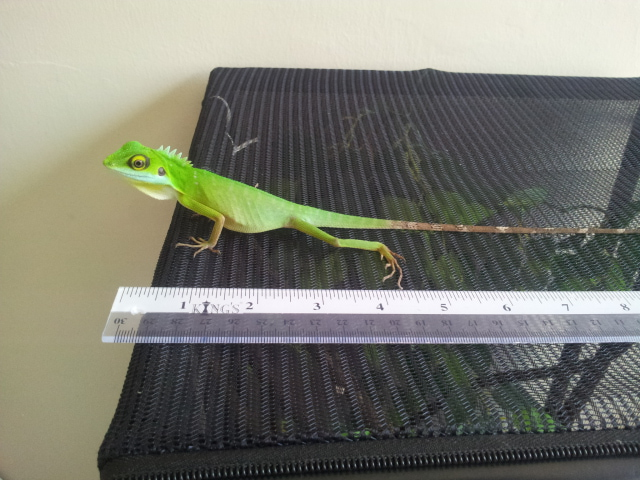 Lizard not eating :(
QuestionCrested Lizard
QUESTION: Hi,
First off,
Lizard not eating :(
QuestionCrested Lizard
QUESTION: Hi,
First off,
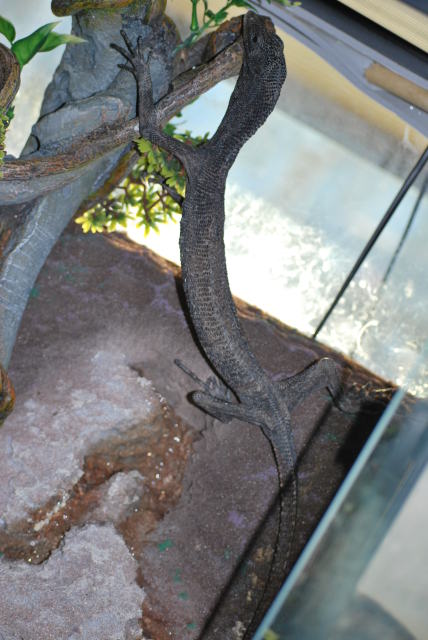 Black Tree monitor
QuestionQUESTION: My black tree monitor will only eat c
Black Tree monitor
QuestionQUESTION: My black tree monitor will only eat c
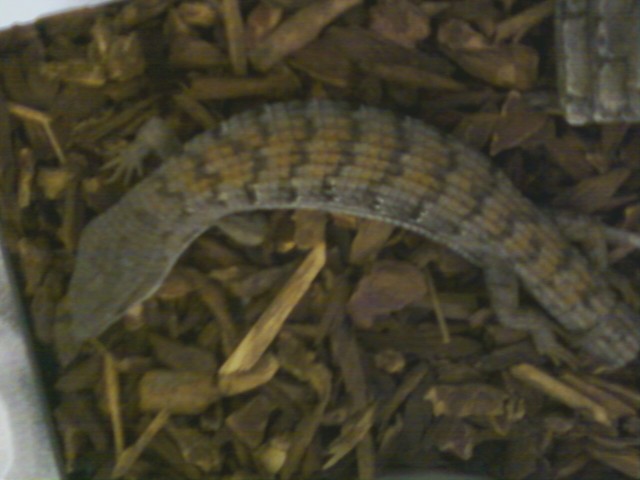 southern alligator lizard-paralysis
Question
Siggy sleeping
Hi, I just found an alligator l
southern alligator lizard-paralysis
Question
Siggy sleeping
Hi, I just found an alligator l